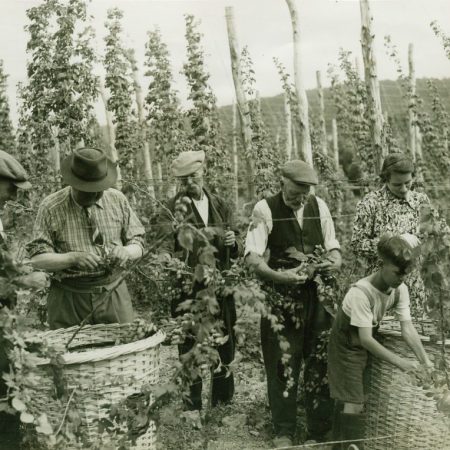After ‘ale’ was overtaken by ‘beer’ in the 1600s, hops – a key companion to Christmas cheer – became an essential ingredient of the national drink and were grown in large quantities in various parts of the county.
A sure sign of places where hops were grown are the ‘oast-houses’, or drying kilns, which are often integrated into some very desirable country properties. There are fine examples near Alton at Hartley Mauditt, on the Hartley Wine Estate, and at Wick Hill Farm. Another can be seen at nearby Binsted at Isington Mill, once the home of Field-Marshall Viscount Montgomery of Alamein.
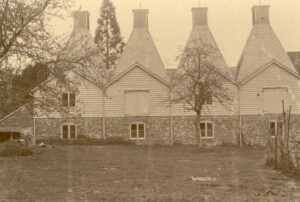
Hops were grown in the Alton area for about 200 years (visit the Curtis Museum, Alton, to learn more). Local gardens had hundreds of ‘hills’ – small mounds of earth bearing a few long poles with several ‘bines’ climbing up each. In the late nineteenth century, wirework provided a more efficient method of stringing the plants. To reach the stems at the top and tie them in, workers got up on stilts. The job also required ‘pole-pullers’ armed with a hook on a pole for grabbing the ‘monkey’, the bit of vine left hanging after the main plant had been harvested.
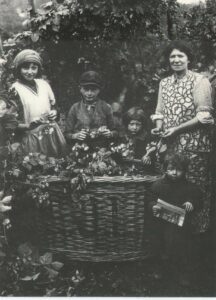
It was a labour-intensive industry and the bines needed regular feeding. In the spring they were given farmyard muck and rags, and in the summer a good dose of guano or phosphates. Regular weeding and hoeing were also essential and in later years spraying with insecticide.
Hops were picked in late summer or early autumn by migrant labour from the countryside or ‘bussed in’ from the cities. Many treated it as a summer holiday. Romany people and other travellers also came in their traditional caravans and ‘benders’.
After picking, the hops were stuffed in ‘pokes’ (a sort of bag) and taken to drying kilns to be laid on a stretched-out cloth above a fire. A touch of sulphur was added to the flames to kill insects and ‘improve’ the colour of the hops. Once cooled, they were raked through a hole in the drying floor and crammed into ‘hop-pockets’. These were cylindrical sacks about six feet tall, weighing about 170 lbs when full.
An Alton hop-farmer who has left a record of his life is William Terrell Gunner (1826-1880), tenant of Will Hall, an ancient farm near the source of the river Wey. From at least 1486 until 2003 it was owned by Winchester College. Gunner married into the Curtis family and left four volumes of diaries, now held by the Hampshire Record Office (284M87/2). Sadly, in 1867 that other sources show that in the well-known murder case Fanny Adams was lured into a hop-field, where her gruesome remains were found.
Hop-picking was often dogged by violent fights between workers. In September 1850 Gunner recorded one on his farm: ‘Last night there was a most awful row among our Irish party. They fell out among themselves and fought like bulldogs – men, women and children. They knocked each other down with hop poles and fought as if they would kill one another. The Police took charge and some, and all who could, left in the morning.’
Life for the hop-grower was a mixed blessing, as Gunner explained: ‘Of all the crops the farmer has to do with, this is the most interesting, causes him more anxiety, requires more attention, costs more to produce and perhaps oftener fails than any other, but at the same time no crop has paid so well.’
In his Rural Rides, the political journalist William Cobbett also remarked on growing hops when he travelled through Selborne in August 1823. A farmer told him that ‘he did not believe there was a more unhappy place in England’. There were many factors at play, but one of them was the state of the hop crop. He wrote: ‘The bines have scarcely got up the poles; the bines and the leaves are black, nearly, as soot… and covered with lice.’ This was probably due to mildew.
Cobbett reported that ‘the hops are equally bad at Alton, Froyle, Crondall and even Farnham’ and elsewhere in the country. Also, he contrived to use the hop duty levied by the government to fire a broadside on ‘vile paper-money’ and investments in stocks and shares. He said that placing a bet on the amount of hop duty – which many people did at the time – was as reprehensible as using a ‘gambling agent, whom [people] call their stockbroker’.
In the minds of some churchmen, the behaviour of the hop pickers in the fields raised important issues of ‘spiritual welfare’. In 1868 the Rev. Samuel Chinn, a Congregational pastor, founded the Alton and District Hop Pickers’ Mission. In association with the London Missionary Society, he erected tents in the hop gardens and proselytised with a blend of tea, comfort and prayer. He later wrote about his experience in Among the Hop- Pickers, published in London by JF Shaw in 1887 (listed in the British Library Catalogue, but not available locally
After Chinn’s death in 1891, the Mission was carried on until WW1 by his daughter, Aurelia, and later by a committee. It continued its work until the mid-1950s, by which time machines had everywhere taken over from itinerant pickers.
The Allen Museum in Alton is dedicated to Farnham artist William Herbert Allen (1863-1943), who for many years was Director of the Farnham School of Art. He generally worked outside and produced many pictures of the hop-fields in Surrey and Hampshire. His works on permanent display in Alton include Hop Kilns and Building the Hayrick at Kings Farm, Binsted, and such subjects as Going Home, The Juice Girl, and Feeding the Chickens.
Hops were also grown in large quantities near Petersfield, as researched by the Buriton Heritage Bank (D Jones, Buriton in Living Memory, 2003, pp. 34-42). The Bonham Carters at Buriton and the Sewards at Weston won many prizes for their produce. The largest hop gardens were alongside Pitcroft Lane, where wild plants still grow, and the hop-kilns were in nearby Bones Lane (http://buriton.org.uk/).
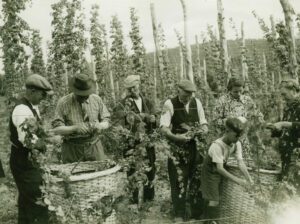
Memories of the drying kilns by a local resident who died in her 80s in 1998 have been recorded. She remembered them as ‘a really magical place, with a lovely warm atmosphere, semi-dark, dimly lit but with very bright fires and the colour and smell of sulphur’. One of the perks for pickers was baking potatoes in the embers.
In some case, three generations of families picked at ‘Buriton Garden City’, as it was called by some. Amongst the many memories recorded by local historians is one from the 1930s explaining how pickers got their jobs: ‘If you intended to go hop-picking, you wrote and asked the foreman of the hop garden if you could have a basket. When picking started you had a message telling you the number of your basket and the day it was to begin.’
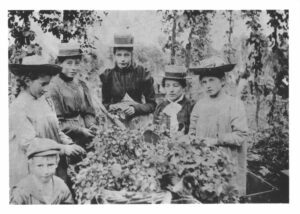
The key fact about hops is that they are the ingredient that distinguishes ‘ale’ from ‘beer’. Throughout the middle-ages, ale was the standard drink, flavoured with wormwood (still used in bitters and such drinks as vermouth and absinthe). Hops were originally added to keep the drink in good condition and the bitterness now sought by drinkers was an incidental effect.
Hops were first grown in what is now Belgium and The Netherlands and came into England near Maidstone, Kent, towards the end of the fifteenth century. As demand rose, an acre of hops was reckoned to be more profitable than fifty acres of corn, though there were risks from drought, floods and fungal disease.
The crop peaked in Britain during the late nineteenth century – in 1878 as many as 77,000 acres were planted. Pasteurisation and the availability of clean water reduced the quantity of hops needed to condition beer. By 1909 the acreage in Britain had more than halved, partly due to a growing taste for foreign beers, which had to be brewed with hops from the Continent, according to ‘the recipe’. By the early 1930s the acreage had halved again.
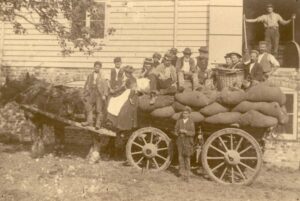
Mechanical picking started in 1922 near Worcester, where a grower imported an American-made machine. Eventually, from 1934 similar machines were manufactured in Britain, notably at Martley and Suckley in Worcestershire, but also at Malvern.
Today there are scarcely 50 farmers in the country, according to the British Hop Association. Some are still in business in the West Midlands, but the majority are in the south-east, notably in Kent, where they were first grown in the late 1400s, As Mr Jingle in Dickens’ Pickwick Papers observed: ‘Kent, sir – everybody knows Kent – apples, cherries, hops and women’.

Author: Dr Barry Shurlock
Bio: Barry is an active local history researcher who writes for the Hampshire Chronicle and other newspapers and contributes to a variety of history journals.
Contact: barryshurlock@gmail.com
This piece was first published in the Hampshire Chronicle on December 22, 2022.

